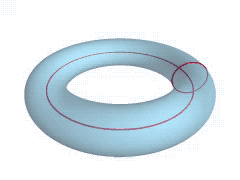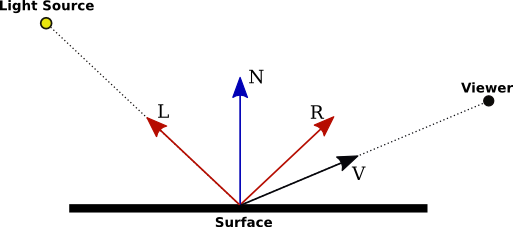甜甜圈
之前偶尔刷到 Joma 的视频 why you NEED math for programming:在终端渲染了一个甜甜圈1,当时只是不明觉厉。最近回忆起来,有点好奇就去研究了下。
他所做的事是:以固定视角,在甜甜圈表面绘制大量对应每个点亮度的像素点,让其看起来是立体的。这些像素点是 ASCII 字符:.,-~:;=!*#$@ 依次代表最暗到最亮。
主要步骤如下2:
- Create a circle of radius R1 centered at R2
- Create a donut by rotating about the Y axes
- Spin the donut around the X and Z axes
- Project donut onto 2D screen
- Determine illumination by calculating surface normal (given a light source)
效果图:
首先我们要有一个甜甜圈(也就是环面),其本质上是一个旋转体。我们以 3D 空间中的点为圆心画一个 2D 的圆,然后让圆绕着环面的中心轴旋转就得到了一个旋转体。

这是穿过环面中心的横切面:
在 xy 平面上,点 (x, y) 绕3圆心 \((R_2, 0, 0)\) 旋转一圈,得到一个半径为 \(R_1\) 的圆,假设旋转角度为 \(\theta\),则圆上每个点的坐标为:
\[(x, y, z) = (R_2, 0, 0) + (R_1 cos\theta, R_1 sin\theta, 0)\]再让圆绕 y 轴旋转另一个角度 \(\phi\),则环面上每个点的坐标为4:
\[(R_2 + R_1 cos\theta, R_1 sin\theta, 0) \cdot \begin{pmatrix} cos\phi & 0 & sin\phi \\ 0 & 1 & 0 \\ -sin\phi & 0 & cos\phi \\ \end{pmatrix}\]如果我们想要动画中整个甜甜圈绕着两个轴转动,假设绕 x 轴转动的角度是 A,绕 y 轴转动的角度是 B,则环面上每个点的坐标为:
\[(R_2 + R_1 cos\theta, R_1 sin\theta, 0) \cdot \begin{pmatrix} cos\phi & 0 & sin\phi \\ 0 & 1 & 0 \\ -sin\phi & 0 & cos\phi \\ \end{pmatrix} \cdot \begin{pmatrix} 1 & 0 & 0 \\ 0 & cosA & sinA \\ 0 & -sinA & cosA \\ \end{pmatrix} \cdot \begin{pmatrix} cosB & sinB & 0 \\ -sinB & cosB & 0 \\ 0 & 0 & 1\\ \end{pmatrix}\]把上面的矩阵乘开,我们就获得了,以原点为中心,绕着 x、y 轴旋转的甜甜圈上所有的点:
\[\left( \begin{matrix} x \\ y \\ z \end{matrix} \right) = \left( \begin{matrix} (R_2 + R_1 \cos \theta) (\cos B \cos \phi + \sin A \sin B \sin \phi) - R_1 \cos A \sin B \sin \theta \\ (R_2 + R_1 \cos \theta) (\cos \phi \sin B - \cos B \sin A \sin \phi) + R_1 \cos A \cos B \sin \theta \\ \cos A (R_2 + R_1 \cos \theta) \sin \phi + R_1 \sin A \sin \theta \end{matrix} \right)\]获得甜甜圈后,我们要把它显示在屏幕上。这是侧视图,一个人在 2D 屏幕前观看后面的 3D 物体:
假设人到屏幕的距离是 \(K_1\),人到物体的距离是 \(K_2\),为了在 2D 屏幕上渲染 3D 物体,我们将 3D 空间中的每个点 (x, y, z),映射到屏幕 (x’, y’, z’)上。人眼、屏幕和人眼、Y 轴形成了两个三角形,它们的关系是:
\[\frac {y'}{y} = \frac {K_1}{K_2 + z}\]推导出:
\[y' = \frac {K_1 y}{K_2 + z}\]同理可得 x’(想象俯视图),所以屏幕上每个点的坐标为:
\[(x', y') = (\frac {K_1 x}{K_2 + z}, \frac {K_1 y}{K_2 + z})\]当我们绘制大量点时,可能在相同位置 (x’, y’) 上绘制甜甜圈上不同位置的点。它们离屏幕的距离(深度)不同,所以我们要维护一个深度缓冲,来存储我们绘制的点的 Z 坐标5,在绘制前判断当前位置是否绘制过。
知道像素点的绘制位置后,我们还需要根据每个点的亮度绘制不同的像素点。假设有一个光源6:

N 是需要计算亮度的点的法线向量,L 是光到达表面方向的反方向向量,它们都是长度为 1 的单位向量,所以 N 与 L 的点积就是这两个向量夹角的余弦值:如果点积大于 0,表面朝向光源;如果点积小于 0,表面背向光源。点积的值越大,表面越亮。
甜甜圈表面法线方向的推导和我们获取甜甜圈的推导类似,当 \(\theta、\phi、A、B\) 相同时,圆上法线方向与以原点为中心的单位圆(半径为 1)相同。
单位圆上的起始点为 \((cos\theta, sin\theta, 0)\),进行相同的转动,表面法线 \((N_x, N_y, N_z)\) 为:
\[(N_x, N_y, N_z) = (cos\theta, sin\theta, 0) \cdot \begin{pmatrix} cos\phi & 0 & sin\phi \\ 0 & 1 & 0 \\ -sin\phi & 0 & cos\phi \\ \end{pmatrix} \cdot \begin{pmatrix} 1 & 0 & 0 \\ 0 & cosA & sinA \\ 0 & -sinA & cosA \\ \end{pmatrix} \cdot \begin{pmatrix} cosB & sinB & 0 \\ -sinB & cosB & 0 \\ 0 & 0 & 1\\ \end{pmatrix}\]这也是甜甜圈的表面法线,再将光源放置在人的后上方 (0, 1, -1),就可以计算出亮度:
\[L = (N_x, N_y, N_z) \cdot (0, 1, -1)\] \[=cos\phi cos\theta sinB - cosA cos\theta sin\phi - sinA sin\theta + cosB (cosA sin\theta - cos\theta sinA sin\phi)\]我们只考虑表面朝向光源的情况(\(L \in [-\sqrt{2}, \sqrt{2}]\)7,取 L > 0),为了将 L 与表示亮度的 11 个 ASCII 字符一一映射,将 \(L \times 8\),值域扩大为 [0, 11]。
齐活!开始写代码8:
package main
import (
"fmt"
"math"
"time"
)
const (
screenWidth = 80
screenHeight = 80
thetaSpacing = 0.07
phiSpacing = 0.02
R1 = 1
R2 = 2
// Calculate K1 based on screen size: the maximum x-distance
// occurs roughly at the edge of the torus, which is at x=R1+R2, z=0. we
// want that to be displaced 3/8ths of the width of the screen, which
// is 3/4th of the way from the center to the side of the screen.
// screen_width*3/8 = K1*(R1+R2)/(K2+0)
// screen_width*K2*3/(8*(R1+R2)) = K1
K1 = screenWidth * K2 * 3 / (8 * (R1 + R2))
K2 = 5
)
func RenderFrame(A, B float64) {
// precompute sines and cosines of A and B
sinA, cosA := math.Sin(A), math.Cos(A)
sinB, cosB := math.Sin(B), math.Cos(B)
output := [screenWidth][screenHeight]byte{}
zBuffer := [screenWidth][screenHeight]float64{}
for i := 0; i < screenWidth; i++ {
for j := 0; j < screenWidth; j++ {
output[i][j] = ' '
zBuffer[i][j] = 0
}
}
// theta goes around the cross-sectional circle of a torus
for theta := 0.0; theta < 2*math.Pi; theta += thetaSpacing {
// precompute sines and cosines of theta
sinTheta, cosTheta := math.Sin(theta), math.Cos(theta)
// phi goes around the center of revolution of a torus
for phi := 0.0; phi < 2*math.Pi; phi += phiSpacing {
// precompute sines and cosines of phi
sinPhi, cosPhi := math.Sin(phi), math.Cos(phi)
// the x,y coordinate of the circle, before revolving
// (factored out of the above equations)
circleX := R2 + R1*cosTheta
circleY := R1 * sinTheta
// final 3D (x,y,z) coordinate after rotations, directly from
// our math above
x := (circleX*(cosB*cosPhi+sinA*sinB*sinPhi) - circleY*cosA*sinB)
y := (circleX*(cosPhi*sinB-cosB*sinA*sinPhi) + circleY*cosA*cosB)
z := K2 + cosA*circleX*sinPhi + circleY*sinA // 实际是 z + K2
ooz := 1 / z // "one over z"
// 在 x,y 坐标系统,x‘,y' 可能为负值,向右上方平移,将坐标全部转化为
// 正值,方便存储在二维数组中
xp := int(screenWidth/2 + 0.5*K1*ooz*x) // 这里乘上系数 0.5
yp := int(screenWidth/2 + K1*ooz*y)
// calculate luminance. ugly, but correct.
L := cosPhi*cosTheta*sinB - cosA*cosTheta*sinPhi - sinA*sinTheta + cosB*(cosA*sinTheta-cosTheta*sinA*sinPhi)
if L > 0 {
// test against the z-buffer. larger 1/z means the pixel is
// closer to the viewer than what's already plotted.
if ooz > zBuffer[xp][yp] {
zBuffer[xp][yp] = ooz
luminanceIndex := int(L * 8)
// luminance_index is now in the range 0..11
// now we lookup the character corresponding to the
// luminance and plot it in our output:
output[xp][yp] = ".,-~:;=!*#$@"[luminanceIndex]
}
}
}
}
// now, dump output[] to the screen.
// bring cursor to "home" location, in just about any currently-used
// terminal emulation mode
fmt.Printf("\x1b[H") // 清空屏幕
for i := 0; i < screenWidth; i++ {
for j := 0; j < screenHeight; j++ {
fmt.Printf("%c", output[i][j])
}
fmt.Println()
}
}
func main() {
var A, B float64 = 1.0, 1.0
for {
A += 0.07
B += 0.03
RenderFrame(A, B)
time.Sleep(100 * time.Millisecond)
}
}
-
原文是 Donut math: how donut.c works,Joma 用视频演绎了一遍。 ↩
-
右手系 ↩
-
实际存的是 \(\frac{1}{z}\):\(\frac{1}{z}=0\) 可以表示无穷远,\(\frac{1}{z}\) 也可以复用。 ↩
-
L \(=\vec{N}\cdot\vec{L}=\lvert\vec{N}\rvert\lvert\vec{L}\rvert cos\alpha,其中\lvert\vec{N}\rvert = 1,\lvert\vec{L}\rvert = \sqrt{2},cos\alpha \in [-1, 1]\) ↩
-
代码从原文中的 C 重写成 Go,但 x’ 乘上了系数 0.5,不然甜甜圈不圆:二维数组的第一维表示列,即纵向,将纵向收缩。 ↩


